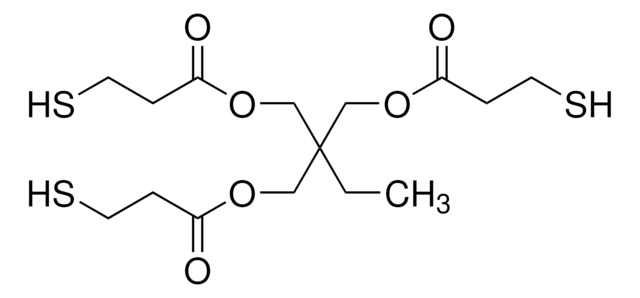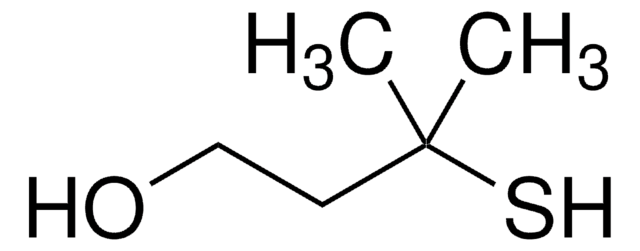328375
1-Mercapto-2-propanol
95%
Se connecterpour consulter vos tarifs contractuels et ceux de votre entreprise/organisme
About This Item
Formule linéaire :
CH3CH(OH)CH2SH
Numéro CAS:
Poids moléculaire :
92.16
Numéro CE :
Numéro MDL:
Code UNSPSC :
12352103
ID de substance PubChem :
Nomenclature NACRES :
NA.23
Produits recommandés
Niveau de qualité
Pureté
95%
Forme
liquid
Indice de réfraction
n20/D 1.486 (lit.)
Point d'ébullition
58-60 °C/17 mmHg (lit.)
Densité
1.048 g/mL at 25 °C (lit.)
Chaîne SMILES
CC(O)CS
InChI
1S/C3H8OS/c1-3(4)2-5/h3-5H,2H2,1H3
Clé InChI
FETFXNFGOYOOSP-UHFFFAOYSA-N
Catégories apparentées
Description générale
1-Mercapto-2-propanol is a chain transferring agent that is the sixth series of hydrogen bonded 1,2-propanols which can be used to form polymeric chains with low molecular weight and short chain length.
Application
1-Mercapto-2-propanol can be used as a self-assembled monolayer on the gold surfaces with potential use in electrochemical applications. It may also be used as a chiral agent which can be used in the chemical analysis of enantiomers.
Code de la classe de stockage
10 - Combustible liquids
Classe de danger pour l'eau (WGK)
WGK 3
Point d'éclair (°F)
145.4 °F - closed cup
Point d'éclair (°C)
63 °C - closed cup
Équipement de protection individuelle
Eyeshields, Gloves, type ABEK (EN14387) respirator filter
Faites votre choix parmi les versions les plus récentes :
Déjà en possession de ce produit ?
Retrouvez la documentation relative aux produits que vous avez récemment achetés dans la Bibliothèque de documents.
Les clients ont également consulté
Determination of enantiomeric excess of some amino acids by second-order calibration of kinetic-fluorescence data.
Naghashian-Haghighi A, et al.
Analytical Biochemistry, 550(1-4), 15-26 (2018)
Microwave spectrum, conformation and intramolecular hydrogen bonding of 1-mercapto-2-propanol
Marstokk KM, et al.
Acta Chemica Scandinavica, 44, 339-345 (1990)
Non-local spatial frequency response of photopolymer materials containing chain transfer agents: II. Experimental results.
Guo J, et al.
Journal of Optics, 13(9), 095602-095602 (2011)
Combinatorial Synthesis and Screening of Novel Odorants Such as Polyfunctional Thiols
Vermeulen C and Collin S
Combinatorial Chemistry & High Throughput Screening, 9, 583-590 (2006)
Ting F Zhu et al.
Proceedings of the National Academy of Sciences of the United States of America, 109(25), 9828-9832 (2012-06-06)
Prior to the evolution of complex biochemical machinery, the growth and division of simple primitive cells (protocells) must have been driven by environmental factors. We have previously demonstrated two pathways for fatty acid vesicle growth in which initially spherical vesicles
Notre équipe de scientifiques dispose d'une expérience dans tous les secteurs de la recherche, notamment en sciences de la vie, science des matériaux, synthèse chimique, chromatographie, analyse et dans de nombreux autres domaines..
Contacter notre Service technique













